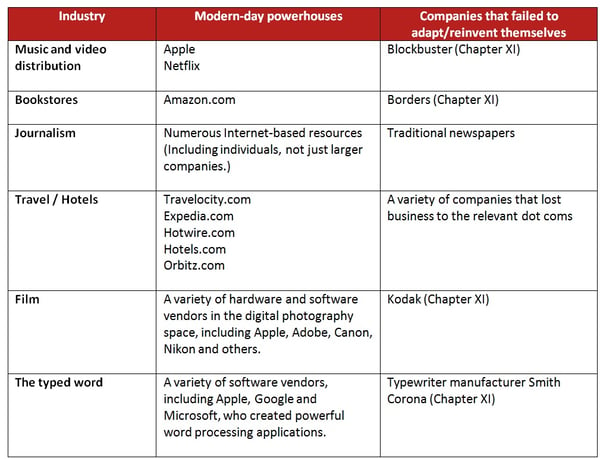Change is Optional, Survival is Not Guaranteed

“Then globalization and the Internet changed everything. Customers suddenly had real choices, access to instant reliable information and the ability to communicate with each other. Power in the marketplace shifted from seller to buyer. Customers started insisting on ‘better, cheaper, quicker and smaller,’ along with ‘more convenient, reliable and personalized.’ Continuous, even transformational, innovation have become requirements for survival.” (Steve Denning [1])
When the Internet gets a hold of an industry, it leaves massive change in its wake
Higher education is at bat. The Internet is pitching. How will we do?
Consider the following industries and the (relatively speaking) nascent companies that are now modern-day powerhouses; consider also those companies that failed to change, adapt and reinvent themselves:
Lessons to be learned:
What can the higher education industry learn from these disappearing and/or failed industries?
Several ideas come to mind:
1. Change is not optional (unless an organization doesn’t want to survive)
Those of us working within higher education can either ride the Internet wave or get crushed by it (bearing in mind that technology can be highly disruptive). At the risk of using phrases and metaphors that sound too much like clichés, these perspectives pack some serious power — minimize them at your organization’s peril. We can either lead/innovate or we can pursue the status quo. If we chose the latter approach, it’s likely our organizations could be a shadow of what they once were.
2. Strategic thinking is critical here
Some questions to consider:
- How will your organization keep from becoming a commodity?
- What does or will your college or university bring to the table that others aren’t able to (or at least to the degree that your organization does)?
- How are you going to differentiate your services and offerings? Price? Delivery methods? Pedagogies used? Ability to place graduates in jobs? Or something else, such as being faith-based or having a different worldview?
- What scenarios do you see coming down the pike that could affect your organization?
- Are you missing some new streams of revenue? If so, where?
3. Cultivate a culture of innovation
For example, have several strategic thinkers on campus join the World Future Society and become knowledgeable in pulse-checking a variety of forces that will affect higher education in the future. Develop some futurists within your organization and start offering more courses and programs in futurism as well as in entrepreneurship.
The bottom line for those of us working within higher education is that people will find a way to make a living. If the current higher education institutions cannot or do not respond significantly enough, they will become like the rock around which water flows.
Evolving Student Needs:
In the future, higher education institutions will likely need to provide products and services that:
- Are personalized and customizable
- More convenient
- Offer more choice and turn more control over to the learner
- Ensure reliable content delivery (and as close to 24 x 7 x 365 as possible)
- Generate up-to-date streams of content
- Offer communities of learners or communities of practice
- Use technologies strategically and, as a result, lower the cost of obtaining a degree
- Provide relevant, real-world practice, mentoring, coaching and opportunities
Closing Thoughts: The Need to Rise Above the Status Quo
Ultimately, the heat in the kitchen increases when the price of a degree that used to be $5,000 per year now costs $35,000 to $65,000+ per year. Different expectations and dynamics start coming into play; more questions begin to surface, such as:
- How will this class/degree help me get a job?
- How is this paper relevant to my future career?
- Will this project help me in getting the gorilla of debt off my back? If so, how?
So change is necessary. But where is the innovation and leadership from within the institutions of traditional higher education? It should bother us that the founders of Udacity and Coursera essentially had to go outside the current system in order to introduce something really new and innovative.
Those of us working within higher education need to double or triple our efforts to reinvent higher education – and to realize that there is danger in the status quo. The fight to not become a commodity has begun and alternatives are already underway; Degreed’s mission to ‘jailbreak’ post-secondary degrees, for example.[2]
If we don’t make these efforts to reinvent ourselves and our institutions, the conversation will continue to move outside traditional institutions of higher education. Like water going around a rock in a quickly flowing stream, people will find a way to make a living.
– – – –
References
[1] Steve Denning, “The Management Revolution That’s Already Happening,” Forbes Magazine, May 30, 2013. Accessed at http://www.forbes.com/sites/stevedenning/2013/05/30/the-management-revolution-thats-already-happening/.
[2] Rip Empson, “Degreed Wants To Jailbreak The College Degree,” TechCrunch, November 18, 2012. Accessed at http://techcrunch.com/2012/11/18/degreed-wants-to-jailbreak-the-college-degree/.
Author Perspective: Educator




